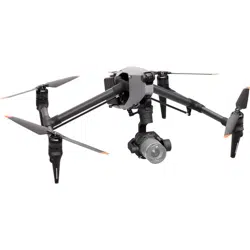Loading ...
Loading ...
Loading ...

DJI Inspire 3
User Manual
22
©
2023 DJI All Rights Reserved.
Aircraft
Aircraft Prole
The Inspire 3 aircraft mainly consists of the ight control system, communication system, vision
system, image processing system, propulsion system, transformation mechanism, and power
and battery system. This chapter provides a detailed introduction to the aircraft components
and functions.
Flight Modes
Flight modes can be switched via the Flight Mode switch on the remote controller.
N-mode (Normal)
The aircraft utilizes GNSS and the forward, backward, lateral, upward, and downward vision
systems, and infrared sensing system to locate and stabilize itself. When the GNSS signal is
strong, the aircraft uses GNSS to locate and stabilize itself. When the GNSS is weak, but the
lighting and other environmental conditions are sucient, the aircraft uses the vision systems
to locate and stabilize itself. When obstacle sensing is enabled and the lighting and other
environment conditions are sucient, the maximum ight speed of the aircraft will be 15 m/s
and the maximum tilt angle of the aircraft will be 35°. When the GNSS signal is weak and the
lighting and other environmental conditions are insucient, the aircraft cannot hover precisely
and can only maintain its altitude.
S-mode (Sport)
The aircraft utilizes the GNSS and downward vision system to hover precisely. By adjusting the
gain and expo settings, the maximum ight speed of the aircraft can be increased to 26 m/s.
When in S-mode, obstacle sensing in the four horizontal directions will be disabled, and the
aircraft cannot detect or bypass obstacles in these directions. The upward and downward vision
systems work normally to achieve the precise hover positioning.
F-mode (Function)
Function mode can be set to T-mode (Tripod mode) or A-mode (Attitude mode) in DJI Pilot 2.
T-mode is based on N-mode. The ight speed is limited to allow easier control of the aircraft.
Attitude mode must be used with caution.
• Obstacle sensing is disabled in S-mode, which means the aircraft cannot sense and
brake to avoid obstacles automatically. Pay attention to the surrounding environment
and obstacles on the route when ying the aircraft in S-mode.
• Note that when flying in S-mode, the flight speed of the aircraft will greatly increase
compared with that in N-mode (Normal). The braking distance will increase signicantly.
When ying in a windless environment, a minimum braking distance of 55 m (180 ft) is
required.
• A minimum braking distance of 15 m (49 ft) is required in windless conditions while the
aircraft is ascending and descending when in S-mode.
Loading ...
Loading ...
Loading ...
